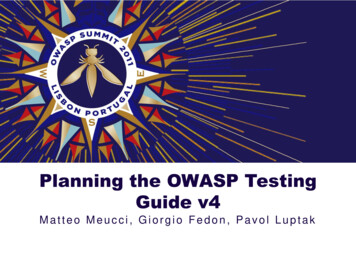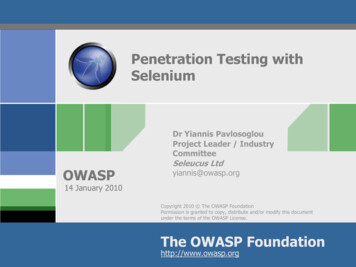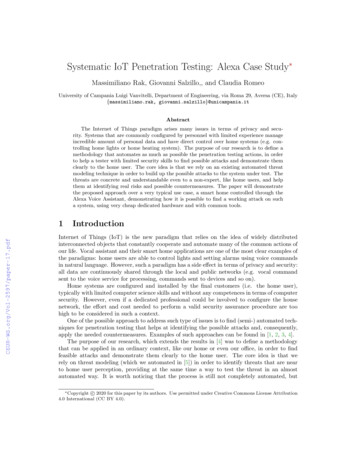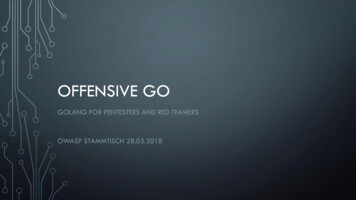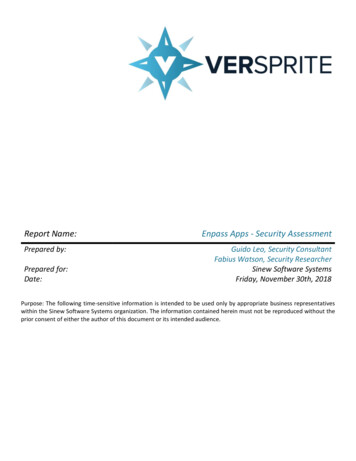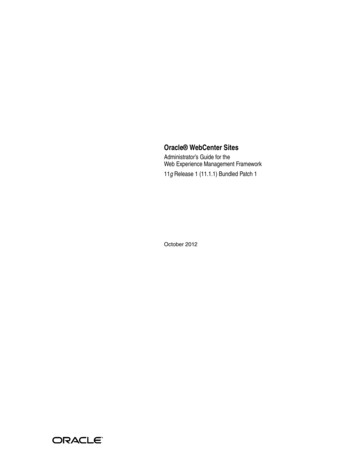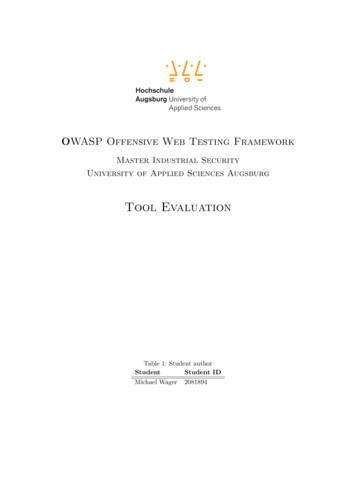
Transcription
OWASP Offensive Web Testing FrameworkMaster Industrial SecurityUniversity of Applied Sciences AugsburgTool EvaluationTable 1: Student authorStudentStudent IDMichael Wager 2081894
Offensive Web Testing FrameworkAbstractPenetration testers often need to work under time pressure. Companies mayhave limited budget but still need high quality results quickly. Therefore it is amajor goal for penetration testers to work as efficient as possible and integratethe use of sophisticated and comprehensive tools to reach this goal.In the context of the lecture Network Penetration Testing at the Universityof Applied Sciences, Augsburg, a collection of such tools will be presented inthis report: the Offensive Web Testing Framework (OWTF) from the OpenWeb Application Security Project (OWASP).First, the motivation of this project will be explained followed by a featureoverview. After a short technical analysis, installation instructions will be given.Afterwards a demonstration of the usage and the tools’ possibilities will bepresented. Finally, a conclusion related the productive use of the tool completesthis document.i
Offensive Web Testing FrameworkContents1 Motivation11.1OWASP Top 10 . . . . . . . . . . . . . . . . . . . . . . . . . . . . . .11.2OWASP Web Security Testing Guide . . . . . . . . . . . . . . . . . .11.3Penetration Testing Execution Standard . . . . . . . . . . . . . . . .21.4NIST SP 800-115 . . . . . . . . . . . . . . . . . . . . . . . . . . . . .22 Features2.12Workflow . . . . . . . . . . . . . . . . . . . . . . . . . . . . . . . . .3 Technical analysis333.1Tech specs . . . . . . . . . . . . . . . . . . . . . . . . . . . . . . . . .33.2Under the hood . . . . . . . . . . . . . . . . . . . . . . . . . . . . . .43.3Architecture . . . . . . . . . . . . . . . . . . . . . . . . . . . . . . . .44 Installation55 Usage65.1User interface . . . . . . . . . . . . . . . . . . . . . . . . . . . . . . .65.1.1Adding targets . . . . . . . . . . . . . . . . . . . . . . . . . .65.1.2Selecting and running plugins . . . . . . . . . . . . . . . . . .75.1.3Report page - analyzing the scan results . . . . . . . . . . . .85.1.4Running and analyzing CLI commands. . . . . . . . . . . .105.1.5Adding notes in the web UI . . . . . . . . . . . . . . . . . . .125.1.6Generating (export) the report . . . . . . . . . . . . . . . . .135.1.7Dashboard . . . . . . . . . . . . . . . . . . . . . . . . . . . .136 Conclusion147 Abbreviations168 References17ii
Offensive Web Testing Framework1 MotivationAs penetration testers often work under time pressure, good tools are needed to workefficiently and deliver high quality results. One such tool which will be analyzed inthis document is the Offensive Web Testing Framework from OWASP. OWTF isa flagship project and open source tool initiated by the OWASP foundation andfocuses on efficiency and alignment of security tests to security standards like theOWASP Testing Guide ([1]), the OWASP Top 10 ([2]), Penetration Testing Execution Standard (PTES) ([3]) and the NIST Technical Guide to Information SecurityTesting and Assessment (NIST SP 800-115 [4]). [5]It tries to reach the following goals: See the big picture and think out of the box More efficiently find, verify and combine vulnerabilities Have time to investigate complex vulnerabilities like business logic Perform more tactical/targeted fuzzing on seemingly risky areas Demonstrate true impact despite the short timeframes we are typically givento test.The tool is highly configurable and it is possible to create own plugins or add newtests in the configuration files without having any development experience. As itis aligned with modern security standards, these standards should be introduced inthe following sub sections.1.1 OWASP Top 10The Open Web Application Security Project (OWASP) is a non-profit foundationdedicated to improving the security of software. The OWASP Top 10 is a standardawareness document for developers and web application security. It represents abroad consensus about the most critical security risks to web applications ([2]). Itdefines the top 10 most critical web application security risks, based on a consensusfrom security experts around the world. Every 2-3 years the list is updated accordingto changes related the field of security. OWTF contains plugins for each of thesevulnerabilities.1.2 OWASP Web Security Testing GuideThe OWASP Testing Guide (current iteration: v4) is a comprehensive guiderelated testing the security of web services and applications ([1]). It gives developers,1
Offensive Web Testing Frameworktesters and management a structured approach for questions like "When, Why &What to test" - specifically related to the Software Development Life Cycle (SDLC).Lots of plugins from OWTF are directly aligned to the tests defined in this guide.1.3 Penetration Testing Execution StandardThe PTES ([3]) is a standard which defines the process of penetration testing. It isstructured into 7 phases:1. Pre-engagement Interactions2. Intelligence Gathering3. Threat Modeling4. Vulnerability Analysis5. Exploitation6. Post Exploitation7. ReportingOWTF is trying to follow this standard and all of its phases.1.4 NIST SP 800-115The SP 800-115 Technical Guide to Information Security Testing and Assessmentfrom the National Institute of Standards and Technology (NIST) is a guide to thebasic technical aspects of conducting information security assessments [4]. Someplugins from OWTF are also directly aligned to the tests defined in this guide.2 FeaturesSome features provided by the tool: Resilience: If one plugin/command crashes, the tool will move on to the next Tests Separation– Passive : No traffic goes to the target– Semi Passive : Normal traffic to target– Active: Direct vulnerability probing Extensive REST API Aligned with OWASP Testing Guide(v3, v4), Top 102
Offensive Web Testing Framework Simple intuitive web interface: manage large penetration engagements easily Report generation and export2.1 WorkflowFigure 1: Workflow ([6])As shown in figure 1, the basic workflow for usage of the tool is pretty straightforward:1. Add target URL(s)2. Run plugins3. Analyse scan results4. Copy commands from web UI to CLI5. Run CLI commands6. Analyse/verify the CLI results7. Add notes in the web UI8. Generate (export) the report3 Technical analysisThis section gives a short overview of the technical specification, the tools runningunder the hood and the architecture of OWTF.3.1 Tech specs python 2.7 PostgreSQL database backend Installation in Kali linux (docker available too) REST API web based user interface to control the tool3
Offensive Web Testing Framework3.2 Under the hood curl Arachni ([7]) - feature-full, modular, high-performance Ruby framework aimedtowards helping penetration testers and administrators evaluate the securityof modern web applications w3af ([8]) - Web Application Attack and Audit Framework Skipfish ([9]) - active web application security reconnaissance tool DirBuster ([10]) - multi threaded java application designed to brute force directories Other well known tools like nmap, hydra, wpscan, whatweb, wapiti, metasploit, etc.3.3 ArchitectureFigure 2: OWTF basic architecture diagramAs shown in figure 2, basic architecture is split into a Frontend, containing a webbased user interface for controlling and using the tool written in JavaScript usingthe popular React.js Framework from Facebook. A simple Express.js based serveris responsible for serving the built assets to the client. The Backend implements aREST-based API written in python and communicates with a PostgreSQL databaseand the command line for executing different commands under the hood when theuser runs plugins. It is possible to think of OWTF as a kind of collection of sophisticated tools for penetration testers, put together behind a nice user interface forcontrolling everything.4
Offensive Web Testing Framework4 InstallationFigure 3: Latest release page on GitHubIt is possible to install all the dependencies on a kali linux machine, but the projectrepository also provides configuration files for a docker-based installation, so forreasons of simplicity the docker based installation will be used. Also the dockerbased installation is recommended by the contributors.The latest official release of OWTF is from march 2019 as shown in figure 3.Installing from docker in this release was not possible due to docker image authentication errors, so instead the latest state of the repository "develop" branch wasused. Following the installation instructions from the official project README file,the installation routine using docker is quite simple and can be executed using thefollowing commands:1 git clone https :// github . com / owtf / owtf2 cd owtf3 make composeThe command make compose pulls a kali linux image and installs all the additional dependencies needed by the tool. After fetching and installing everything itfinally starts the tool as shown in figure 4. Now the database is up and running, aproxy to the API and a webserver is listening for requests and the web based userinterface can be accessed via a browser at the URL http://localhost:8009/.5
Offensive Web Testing FrameworkFigure 4: OWTF startup terminal output5 UsageThe following sections will walk the reader through the different screens accordingto the workflow described above.5.1 User interfaceAfter installing and running the tool, the web based user interface is available andcan be accessed via a web browser. First we want to add a target to scan.5.1.1 Adding targetsFigure 5: Screenshot of the UI screen after adding a target URL6
Offensive Web Testing FrameworkFigure 5 shows a screenshot of the UI after adding the target URL to our vulnerable target (http://testphp.vulnweb.com/ [11])), a web application with a vastnumber of intended security vulnerabilities, developed for educational purposes. Asthis web application has lots of known vulnerabilities, the author decided to use thisapplication as the target for all further demonstration.5.1.2 Selecting and running pluginsAfter adding a target, plugins may be started. Plugins have the following structure:OWTF-IG-004 Web Application FingerprintUnder the hood, plugins use command line tools to scan the target(s). For example, the plugin "Web Application Fingerprint" is using curl and whatweb to do itsjob. The phrase "OWTF-IG-004" is a reference to the OWASP Testing Guide ([1])and a relation to the chapter "Information gathering" and section "Fingerprint WebServer".Other plugins like for example PTES-001 ftp reference the Penetration testing execution standard ([3]). Behind the scenes, this plugin uses the "msfconsole"command line tool from the popular metasploit framework.Figure 6 shows the modal window for selecting the plugins to execute againstthe target. It is possible to launch plugins in groups or individual. On individualselection, text based search is possible to explicitly search for vulnerabilities like"SQL injection" or "Cross site scripting".Figure 6: Screenshot of the UI modal window for selecting plugins7
Offensive Web Testing FrameworkPlugin groupsThis section explains the plugin groups and types based on the official documentation [12]. webThis group contains plugins related basic web capabilities like web applicationfingerprint or SQL injection auxiliaryBruteforce and actual explotation tools networkNetwork based scanning tools like DirBusterPlugin types passive semi passive active dos exploit selenium bruteforce external grepFirst it would be nice to gather some basic information about our target like theIP address, the server on which the site is running on or some information about theframework and tools used by the application. Therefore we start the plugin "OWTFIG-004 Web Application Fingerprint", which uses "whatweb" and "curl" under thehood.5.1.3 Report page - analyzing the scan resultsIn Figure 7 the detail page of a target after running the fingerprint plugin is shown.The left sidebar provides options for filtering plugin results based on plugin groupsand plugin types and generating and downloading the final report. In the middle, runplugins are rendered including the plugin type and the title of the plugin. Clicking8
Offensive Web Testing Frameworkon one of the plugins opens a flyover window on the right of the screen for viewingthe plugin output or adding custom notes. It is possible to categorize the pluginin the following states: Unranked, Passing, Info, Low, Medium, High andCritical. This is helpful for filtering later and to better organize our work. Clickingon the Browse button opens the results of the scan in a new window.Figure 7: Screenshot of the UI page of a target after running the plugin "WebApplication Fingerprint"The result of the underlying "whatweb" command looks like this:http://testphp.vulnweb.com/ [200 OK] -Flash, Country[UNITED cromedia.com/.PHP[5.6.40-38 ubuntu20.04.1 deb.sury.org 1]Script[text/JavaScript]Title[Home of Acunetix /5.6.40-38 ubuntu20.04.1 deb.sury.org 1]nginx[1.19.0]So among other information, this tells us that the site is served by an nginx serverin version 1.19.0, it runs on PHP 5.6.40 and it is using JavaScript. Looks like aregular web application, so we are going to try some active vulnerability scanning.We select the plugin OWTF-WVS-006 Skipfish Unauthenticated. The plugin9
Offensive Web Testing Frameworkunfortunately runs into an error, but it tells us which command it wants to run. Wenow want to try the command manually.5.1.4 Running and analyzing CLI commandsWe open a terminal inside the docker container with the following command:1 docker exec - it docker owtf 1 bashNow that we have a shell inside the kali linux docker container we can executethe commands just like OWTF would. After some tweaking we try the following:1touch new dict . wl2skipfish -t 9 0 -i 9 0 -w 9 0 -f 1 0 0 0 -b f -o / tmp / skip -W ./new dict . wl http :// testphp . vulnweb . comFigure 8 shows a screenshot of the command terminal output.Figure 8: Screenshot of the Terminal output of the skipfish command10
Offensive Web Testing FrameworkAfter the command run, it generated an html report which we download to ourhost for inspection. Figure 9 shows a screenshot of the report.Figure 9: Screenshot of the skipfish reportAnalyzing the report we see 16 XSS vectors. The web application allows usersto list products filtering for a category.The parameter payload for the URLhttp://testphp.vulnweb.com/listproducts.php looks like this:?cat %22. 352075%3ENavigating to that URL renders a MySQL exception, which is a hint that we mayinject code:Error: You have an error in your SQL syntax; check the manual thatcorresponds to your MySQL server version for the right syntax touse near ’"’ at line 1 Warning: mysql fetch array() expectsparameter 1 to be resource, boolean given in/hj/var/www/listproducts.php on line 74After some manual playing with this payload we found a working reflected XSSinjection using the following payload:1? cat ". . htaccess . aspx - - " ’ ’" script alert ( ’ OK ’) /script Here is a link to the full working exploit URL: LinkFigure 10 shows a screenshot of the successful exploit.11
Offensive Web Testing FrameworkFigure 10: Successful exploit of a reflected XSS vector5.1.5 Adding notes in the web UINow that we found a successful exploit we go back to the user interface and addsome notes to our plugin and categorize the plugin run as critical. See Figure 11 fora detailed screenshot.Figure 11: Screenshot of adding manual notes to a plugin12
Offensive Web Testing Framework5.1.6 Generating (export) the reportUnfortunatly, exporting the report seems to be broken. After some analysis of theinner workings, an issue on GitHub was created by the .7 DashboardFinally we take a look at the dashboard which could also be very helpful for reportingour work. Figure 12 shows a screenshot of the dashboard. As seen in the screenshot,the used categorization inside the plugin views are represented here in a nice lookingchart.Figure 12: Screenshot of the dashboard13
Offensive Web Testing Framework6 ConclusionThe first impression of the tool including its motivation, goals and features lookedreally impressive. Having a tool supporting the complete process of penetrationtesting, aligned to security standards and containing support for automatic reportgeneration really could enhance the life of a security tester. Setup and installationwas quite simple and pretty straightforward. Supporting a docker based installationdeserves some bonus points too. But after exploring and trying to use the tool in aproductive way, the overall experience was pretty disappointing.Lots of features just don’t work as expected and are running into an error. Thefollowing list gives an overview and documents the author’s findings: Starting pluginsStarting plugins, especially multiple at the same time or in groups, randomlyleads to an error with the message "Unable to add Error: Bad Request". ThePOST request returns a status code 400 Bad Request with the error "Pluginlist should not be empty", even though the checkboxes for selecting plugin(groups) was selected before clicking the "Run" button. Looking at the plugin resultsLooking at the plugin results is not possible in some cases.Clicking onthe "Browse" button to view a plugins’ results navigates to an URL likehttp://localhost:8010/null/ with a status code 404 Not Found. Report generation and downloadClicking on the "Export Report" button leads to a white screen and aJavaScript error in the DevTools console saying "The menu has no menuitems". An issue at the git repository on GitHub was created by the author:https://github.com/owtf/owtf/issues/1149 Tools not foundSometimes when running a plugin, the tools does not seem to be installedinside the docker based virtual machine (e.g. theHarvester: command notfound)Nevertheless it should be kept in mind that OWTF is a free, open source solutioncontaining lots of work (the repository was created in January 2012), as can be seenlooking at the git source repository history. Also, it is under active developmentand there is a web page for addressing and optimizing some pain points in thecontext of the google summer of code 2021 [13]. For example they want to enhancethe user experience and are searching for developers implementing some overallimprovements. The author had some discussion on the development slack channel14
Offensive Web Testing Frameworkand the maintainers responded quickly, were thankful for reporting these issues andwant to address them very soon.Finally, in the opinion of the author, at current stage there are too many issues andlots of debugging needed, so the tool just not seem to be ready for production use.But as the tool is still under active development, is is possible that the contributorsadd more documentation and fix the found issues in the foreseeable future and it isdefinitely worth following the development of this promising solution.15
Offensive Web Testing Framework7 AbbreviationsNISTNational Institute of Standards and TechnologyOWASP Open Web Application Security ProjectOWTF Offensive Web Testing FrameworkPTES Penetration Testing Execution StandardSDLC Software Development Life Cycle16
Offensive Web Testing Framework8 References[1]OWASP, OWASP Testing Guide, 11.06.2021. [Online]. Available: /.[2]OWASP, OWASP Top 10, 11.06.2021. [Online]. Available: https://owasp.org/www-project-top-ten/.[3] Penentration Testing Execution Standard, 11.06.2021. [Online]. p/Main Page/.[4] NIST SP 800-115 Information Security Testing and Assessment, 29.06.2021.[Online]. Available: https : / / nvlpubs . nist . gov / nistpubs / Legacy / SP /nistspecialpublication800-115.pdf.[5] OWTF at GitHub, 11.06.2021. [Online]. Available: https : / / github . com /owtf/owtf/.[6]J. Brennen, Automating Security Testing with the OWTF by Jerod Brennen, 11.06.2021. [Online]. Available: https : / / www . youtube . com / watch ?v 03o2FdNK4IY.[7] Arachni - Web Application Security Scanner Framework, 11.06.2021. [Online].Available: https://www.arachni-scanner.com/.[8] w3af - Web Application Attack and Audit Framework, 11.06.2021. [Online].Available: http://w3af.org/.[9] Skipfish - active web application security reconnaissance tool, 11.06.2021. [Online]. Available: [10] DirBuster - multi threaded java application designed to brute force directoriesand files names on web/application servers, 11.06.2021. [Online]. dirbuster/.[11] example PHP application, intentionally vulnerable to web attacks, 11.06.2021.[Online]. Available: http://testphp.vulnweb.com/.[12] OWTF official documentation, 11.06.2021. [Online]. Available: https://owtf.readthedocs.io/.[13] Google Sommer of code 2021 - Ideas, 11.06.2021. [Online]. Available: soc2021ideas/.17
OWASP Offensive Web Testing Framework Master Industrial Security University of Applied Science


